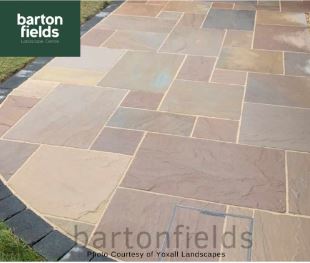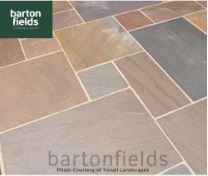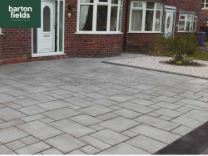Your shopping cart is empty!

Creating a beautiful and functional patio can enhance the look and value of your home while providing a space for outdoor relaxation and entertainment. When it comes to choosing the best paving and slabs for your patio, there are many options to consider. In this article, we'll discuss the most popular types of patio slabs, their advantages and disadvantages, and some tips for installation and maintenance.
 Sandstone is a popular choice for patios because of its durability, natural beauty, and versatility. Indian Sandstone, in particular, is a popular type of sandstone paving that comes in a wide range of colors and textures. It is also relatively affordable compared to other types of natural stone paving, making it an excellent choice for homeowners on a budget.
Sandstone is a popular choice for patios because of its durability, natural beauty, and versatility. Indian Sandstone, in particular, is a popular type of sandstone paving that comes in a wide range of colors and textures. It is also relatively affordable compared to other types of natural stone paving, making it an excellent choice for homeowners on a budget.
 Natural stone paving, such as limestone, granite, and slate, is a premium option for patios. It is known for its unique beauty, durability, and longevity. Natural stone is also a sustainable option since it is sourced from the earth and does not require any manufacturing processes.
Natural stone paving, such as limestone, granite, and slate, is a premium option for patios. It is known for its unique beauty, durability, and longevity. Natural stone is also a sustainable option since it is sourced from the earth and does not require any manufacturing processes.
 Concrete paving slabs are a popular choice for patios because of their affordability, versatility, and durability. They come in a wide range of colors, shapes, and sizes, making it easy to create a customized patio design.
Concrete paving slabs are a popular choice for patios because of their affordability, versatility, and durability. They come in a wide range of colors, shapes, and sizes, making it easy to create a customized patio design.
If you're looking for patio slabs that can withstand heavy foot traffic, furniture, and weather, here are some of the best options:
The thickness of paving slabs will depend on the intended use and the weight they will need to bear. For most patios, a thickness of 20-30mm is sufficient. However, if the patio will be used for heavy furniture, vehicles, or equipment, thicker slabs may be necessary.
It is recommended to use a cement-based mortar between paving slabs to ensure a strong and stable patio. The mortar will fill the gaps between the slabs, preventing them from shifting or moving over time.
Yes, it is recommended to leave a gap of at least 10-15mm between paving slabs to allow for expansion. However, certain situations do not require this, such as slabs underneath a shed.
A common question homeowners have when installing patio slabs is whether they need a membrane under the slabs. A membrane is a thin layer of material that's placed between the soil and the slabs to prevent weeds from growing through and to help stabilize the slabs. While not strictly necessary, a membrane can help ensure that your patio remains level and weed-free over time.
Another common issue with patio slabs is that they can come loose over time. This can be caused by a variety of factors, including:
To prevent patio slabs from coming loose, it's important to ensure they are properly installed and to maintain them regularly. This includes checking for signs of wear and tear, keeping the area clean and free of debris, and addressing any water damage immediately.
When installing patio slabs, it's important to use the right type of sand. There are two main types of sand used in patio installation: sharp sand and building sand. Sharp sand is a coarse, gritty sand that's best used as a base layer. Building sand is a finer sand that's better for filling gaps between the slabs. Typically, it's recommended to use a combination of both sharp sand and building sand when installing patio slabs. This helps ensure a stable base and provides a secure foundation for the slabs.
Selecting the right paving and slabs for your patio can make or break the appearance and also longevity of your patio. Various stones and materials are available to you, and which you choose can have a dramatic effect on your garden. For our full range of patio slabs and paving, please see out patio paving page.